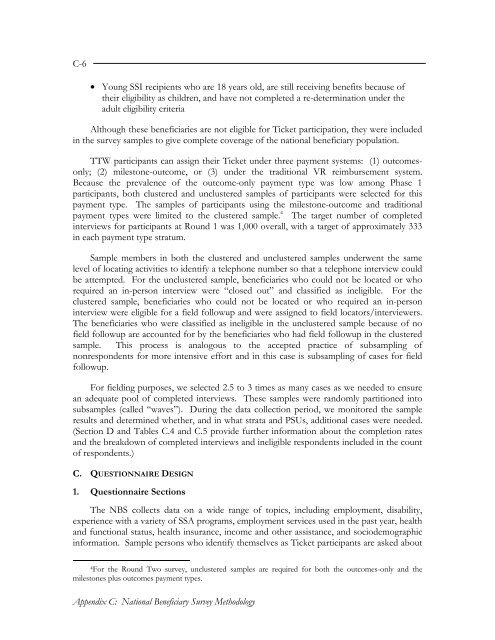Evaluation of the Ticket to Work Program, Implementation ...
Evaluation of the Ticket to Work Program, Implementation ...
Evaluation of the Ticket to Work Program, Implementation ...
Create successful ePaper yourself
Turn your PDF publications into a flip-book with our unique Google optimized e-Paper software.
C-6• Young SSI recipients who are 18 years old, are still receiving benefits because <strong>of</strong><strong>the</strong>ir eligibility as children, and have not completed a re-determination under <strong>the</strong>adult eligibility criteriaAlthough <strong>the</strong>se beneficiaries are not eligible for <strong>Ticket</strong> participation, <strong>the</strong>y were includedin <strong>the</strong> survey samples <strong>to</strong> give complete coverage <strong>of</strong> <strong>the</strong> national beneficiary population.TTW participants can assign <strong>the</strong>ir <strong>Ticket</strong> under three payment systems: (1) outcomesonly;(2) miles<strong>to</strong>ne-outcome, or (3) under <strong>the</strong> traditional VR reimbursement system.Because <strong>the</strong> prevalence <strong>of</strong> <strong>the</strong> outcome-only payment type was low among Phase 1participants, both clustered and unclustered samples <strong>of</strong> participants were selected for thispayment type. The samples <strong>of</strong> participants using <strong>the</strong> miles<strong>to</strong>ne-outcome and traditionalpayment types were limited <strong>to</strong> <strong>the</strong> clustered sample. 4 The target number <strong>of</strong> completedinterviews for participants at Round 1 was 1,000 overall, with a target <strong>of</strong> approximately 333in each payment type stratum.Sample members in both <strong>the</strong> clustered and unclustered samples underwent <strong>the</strong> samelevel <strong>of</strong> locating activities <strong>to</strong> identify a telephone number so that a telephone interview couldbe attempted. For <strong>the</strong> unclustered sample, beneficiaries who could not be located or whorequired an in-person interview were “closed out” and classified as ineligible. For <strong>the</strong>clustered sample, beneficiaries who could not be located or who required an in-personinterview were eligible for a field followup and were assigned <strong>to</strong> field loca<strong>to</strong>rs/interviewers.The beneficiaries who were classified as ineligible in <strong>the</strong> unclustered sample because <strong>of</strong> n<strong>of</strong>ield followup are accounted for by <strong>the</strong> beneficiaries who had field followup in <strong>the</strong> clusteredsample. This process is analogous <strong>to</strong> <strong>the</strong> accepted practice <strong>of</strong> subsampling <strong>of</strong>nonrespondents for more intensive effort and in this case is subsampling <strong>of</strong> cases for fieldfollowup.For fielding purposes, we selected 2.5 <strong>to</strong> 3 times as many cases as we needed <strong>to</strong> ensurean adequate pool <strong>of</strong> completed interviews. These samples were randomly partitioned in<strong>to</strong>subsamples (called “waves”). During <strong>the</strong> data collection period, we moni<strong>to</strong>red <strong>the</strong> sampleresults and determined whe<strong>the</strong>r, and in what strata and PSUs, additional cases were needed.(Section D and Tables C.4 and C.5 provide fur<strong>the</strong>r information about <strong>the</strong> completion ratesand <strong>the</strong> breakdown <strong>of</strong> completed interviews and ineligible respondents included in <strong>the</strong> count<strong>of</strong> respondents.)C. QUESTIONNAIRE DESIGN1. Questionnaire SectionsThe NBS collects data on a wide range <strong>of</strong> <strong>to</strong>pics, including employment, disability,experience with a variety <strong>of</strong> SSA programs, employment services used in <strong>the</strong> past year, healthand functional status, health insurance, income and o<strong>the</strong>r assistance, and sociodemographicinformation. Sample persons who identify <strong>the</strong>mselves as <strong>Ticket</strong> participants are asked about4 For <strong>the</strong> Round Two survey, unclustered samples are required for both <strong>the</strong> outcomes-only and <strong>the</strong>miles<strong>to</strong>nes plus outcomes payment types.Appendix C: National Beneficiary Survey Methodology
















